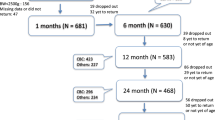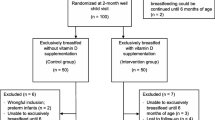Abstract
Since no foods are vitamin D supplemented in Greece, vitamin D status was assessed in mothers at birth and their infants up to the first 6 months of life, while they were exclusively breast-fed. This was a prospective study. Full-terms ( n =35) born during the summer-autumn months and their mothers were assigned to the summer group and the remainder ( n =31) to the winter group. One week after birth, serum 25-hydroxyvitamin D (25OHD) was significantly lower in the winter-born than in the summer-born neonates (6.7±0.7 vs. 10.1±0.9 ng/ml, P <0.01). The respective levels of parathyroid hormone (iPTH) were 64.9±13.4 and 33.9±4.4 pg/ml ( P <0.01). The mothers had serum 25OHD levels of 10.8±1.0 ng/ml and iPTH levels of 15.2±3.5 pg/ml in the winter and 12.9±1.3 ng/ml and 24.8±4.8 pg/ml in the summer. During the 6-month follow-up, a steady increase in circulating 25OHD (up to 19.4±2.8 ng/ml, P <0.0001) and a decrease in iPTH (to 26.8±3.5 pg/ml, P =0.10) were observed in the infants born in the winter. In the summer-born infants, serum 25OHD did not change but iPTH had increased significantly by the 3rd month (59.4±21.8, P <0.05). Serum calcium (Ca) increased within normal limits during the study period in both groups. Serum phosphorus (Pi) started higher in the winter group (7.43±0.38 vs. 6.27±0.23 mg/dl, P <0.01) but thereafter, it was similar in both groups. Total alkaline phosphatase (ALP) increased in both groups during the study (164±15 vs. 219±17 IU/l, P <0.05 and 189±14 vs. 288±35 IU/l, P <0.001, respectively). Serum osteocalcin (OC) decreased in the winter-born neonates (32.0±3.4 vs. 21.5±3.4 ng/ml, P <0.05) and did not change in the summer group (28.9±3.5 vs. 26.5±2.8 ng/ml). Conclusion:Neonates who are breast-fed exclusively during the first 6 months of life are in need of vitamin D supplementation irrespective of the season even in a sunny country like Greece where foods are not supplemented.

Similar content being viewed by others

Abbreviations
- ALP :
-
total alkaline phosphatase
- Ca :
-
calcium
- CHL :
-
crown-heel length
- 25OHD :
-
25-hydroxyvitamin D
- iPTH :
-
intact parathyroid hormone
- OC :
-
osteocalcin
- Pi :
-
inorganic phosphorus
References
Baroncelli GI, Berteloni S, Ceccarelli C, Amato V, Saggese G (2000) Bone turnover in children with vitamin D deficiency rickets before and during treatment. Acta Paediatr 89: 513–518
Brooke OG, Brown IR, Bone CD, Carter ND, Cleeve HJ, Maxwell JD, Robinson VP, Winder SM (1980) Vitamin D supplements in pregnant Asian women: effects on calcium status and fetal growth. BMJ 280: 751–754
Brooke OG, Butters F, Wood C (1981) Intrauterine vitamin D nutrition and postnatal growth in Asian infants. BMJ 283: 1024
Canadian Pediatric Society. Nutrition for healthy term infants: statement of the joint working group. Available at:http://www.caringforkids.cps.ca/babies/Vitamin D.htm
Cantorna MT (2000) Vitamin D and autoimmunity: is vitamin D status an environmental factor affecting autoimmune disease prevalence? Proc Soc Exp Biol Med 223: 230–233
Challa A, Bevington A, Anger C, Asbury A, Preston C, Russell R (1985) A technique for the measurement of orthophosphate in human erythrocytes, and some studies of its determinants. Clin Sci 285: 763–768
Dawodu A, Agarwal M, Hossain M, Kochiyil J, Zayed R (2003) Hypovitaminosis D and vitamin D deficiency in exclusively breast-fed infants and their mothers in summer: a justification for vitamin D supplementation of breast-feeding infants. J Pediatr 142: 169–173
Delvin EE, Salle BL, Glorieux FH, Adeleine P, David LS (1986) Vitamin D supplementation during pregnancy: effect on neonatal calcium homeostasis. J Pediatr 109: 328–334
Dewey KG (2001) Nutrition, growth and complementary feeding of the breastfed infant. Pediatr Clin North Am 48: 87–104
Gartner LM, Greer FR (2003) American Academy of Pediatrics Section on Breastfeeding and Committee on Nutrition. Prevention of rickets and vitamin D deficiency: new guidelines for vitamin D intake. Pediatrics 111: 908–910
Gertner JM, Glassman MS, Coustan DR, Goodman DB (1980) Fetomaternal vitamin D relationship at term. J Pediatr 97: 637–640
Gessner BD, Plotnik J, Muth PT (2003) 25-hydroxyvitamin D levels among healthy children in Alaska. J Pediatr 143: 434–437
Greer FR (2001) Do breastfed infants need supplemental vitamins? Pediatr Clin North Am 48: 415–423
Greer FR (2003). Vitamin D deficiency—it’s more than rickets. J Pediatr 143: 422–423
Greer FR, Marshall S (1989) Bone mineral content, serum vitamin D metabolite concentrations and ultraviolet B light exposure in infants fed human milk with and without vitamin D2 supplements. J Pediatr 114: 204–212
Heaney RP, Dowell MS, Hale CA, Bendich A (2003) Calcium absorption varies within the reference range for serum 25-hydroxyvitamin D. J Am Coll Nutr 22: 142–146
Holick MF (2004) Vitamin D: importance in the prevention of cancers, type 1 diabetes, heart disease and osteoporosis. Am J Clin Nutr 79: 362–371
Hoogenboezem T, Degenhart HJ, De Muinck Keizer-Schrama SM, Bouillon R, Grose WF, Hackeng WH, Visser HK (1989) Vitamin D metabolism in breast-fed infants and their mothers. Pediatr Res 25: 623–628
Institute of Medicine, Food and Nutrition Board, Standing Committee on the Scientific Evaluation of Dietary Reference Intakes (1997) Vitamin D. In: Dietary reference intakes for calcium, phosphorus, magnesium, vitamin D and fluoride. National Academy Press, Washington, pp 250–287
Lebrun JB, Moffatt ME, Mundy RJ, Sangster RK, Postl BD, Dooley JP, Dilling LA, Godel JC, Haworth JC (1993) Vitamin D deficiency in a Manitoba community. Can J Public Health 84: 394–396
Mallet E, Gugi B, Brunelle P, Henocq A, Basuyau JP, Lemeur H (1986) Vitamin D supplementation in pregnancy: a controlled trial of two methods. Obstet Gynecol 68: 300–304
Markestad T, Kolmannskog S, Arntzen E, Toftegaard L, Haneberg B, Asknes L (1984) Serum concentrations of vitamin D metabolites in exclusively breast-fed infants at 70 degrees north. Acta Paediatr Scand 73: 29–32
McMurray DN, Bartow RA, Mintzer CL, Hernadez-Frontera E (1990) Micronutrient status and immune function in tuberculosis. Ann N Y Acad Sci 587: 59–69
Muhe L, Lulseged S, Mason KE, Simoes EA (1997) Case-control study of the role of nutritional rickets in the risk of developing pneumonia in Ethiopian children. Lancet 349: 1801–1804
Nikiforuk G, Fraser D (1981) The etiology of enamel hypoplasia: a unifying concept. J Pediatr 98: 888–893
Rothberg AD, Pettifor JM, Coben DF, Sonnendecker EW, Ross FP (1982) Maternal infant vitamin D relationships during breast-feeding. J Pediatr 101: 500–503
Salle BL, Delvin EE, Lapillonne A, Bishop NJ, Glorieux FH (2000) Perinatal metabolism of vitamin D. Am J Clin Nutr 71[Suppl 5]: 1317S–1324S
Wharton B, Bishop N (2003) Rickets. Lancet 362: 1389–1400
Wilkinson RJ, Llewelyn M, Toossi Z, Patel P, Pasvol G, Lalvani A, Wright D, Latif M, Davidson RN (2000) Influence of vitamin D deficiency and vitamin D receptor polymorphisms on tuberculosis among Gujarati Asians in west London: a case control study. Lancet 355: 618–621
Zeghoud F, Vervel C, Guillozo H, Walrant-Debray O, Boutignon H, Garabedian M (1997) Subclinical vitamin D deficiency in neonates: definition and response to vitamin D supplements. Am J Clin Nutr 65: 771–778
Acknowledgements
We thank Ms Afroditi Papaghianni for her technical assistance and Hoffman La Roche for providing the ‘cold’ vitamin D metabolites.
Author information
Authors and Affiliations
Corresponding author
Rights and permissions
About this article
Cite this article
Challa, A., Ntourntoufi, A., Cholevas, V. et al. Breastfeeding and vitamin D status in Greece during the first 6 months of life. Eur J Pediatr 164, 724–729 (2005). https://doi.org/10.1007/s00431-005-1757-1
Received:
Revised:
Accepted:
Published:
Issue Date:
DOI: https://doi.org/10.1007/s00431-005-1757-1



